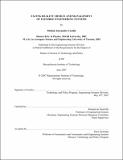| dc.contributor.advisor | Richard de Neufville. | en_US |
| dc.contributor.author | Cardin, Michel-Alexandre, 1979- | en_US |
| dc.contributor.other | Massachusetts Institute of Technology. Technology and Policy Program. | en_US |
| dc.date.accessioned | 2008-02-27T20:36:28Z | |
| dc.date.available | 2008-02-27T20:36:28Z | |
| dc.date.copyright | 2007 | en_US |
| dc.date.issued | 2007 | en_US |
| dc.identifier.uri | http://hdl.handle.net/1721.1/40301 | |
| dc.description | Thesis (S.M.)--Massachusetts Institute of Technology, Engineering Systems Division, Technology and Policy Program, 2007. | en_US |
| dc.description | This electronic version was submitted by the student author. The certified thesis is available in the Institute Archives and Special Collections. | en_US |
| dc.description | Includes bibliographical references (p. 108-112). | en_US |
| dc.description.abstract | This thesis proposes a practical approach to defining flexible design and development strategies for maximizing the expected value of engineering systems. Specifically, the approach deals with the fact that it is generally computationally impractical to explore all the possible ways a system might be developed and operated, given the large number of possible scenarios in which the system might evolve. To make the analysis tractable within the computational resources available, it proposes that designers and program managers use a catalog of representative operating plans built from combinations of design elements and management decision rules. These are associated with a range of possible scenarios of uncertain variables that might affect the system's expected value and performance. This work develops the novel methodology introduced by (de Neufville, 2006) to guide the search for catalogs of operating plans while aiming at minimizing computational effort. It assumes a model of the engineering system is available, together with several value/performance metrics such as Expected Net Present Value (ENPV) and Value At Risk and Gain (VARG). It uses an algorithm based on statistical experiment design, Adaptive One-Factor-At-a-Time (OFAT) (Frey and Wang, 2006; Wang, 2007), to search the combinatorial space in light of system's responses to a limited set of uncertain variable scenarios. | en_US |
| dc.description.abstract | (cont.) Two case studies demonstrate the benefits of the analysis methodology. One is inspired from the development of a parking garage near the Bluewater commercial center in the United Kingdom. The other relates to the development of a real estate project in the United States. Results from case studies show improvement compared to inflexible design of engineering systems while still requiring minimal computational effort. This, together with appropriate policy recommendations, provides incentives for dissemination of the analysis methodology in industry and government. The simplicity of the methodology and use of tools already familiar to the firm and government agency alleviate political barriers to implementation. It allows designers and program managers to remain within established framework, rules, and management constraints. It favors transparent presentation and efficient application to design and management of engineering systems, thus allowing program managers to present the natural evolution of decisions to senior decision-makers. | en_US |
| dc.description.statementofresponsibility | by Michel-Alexandre Cardin. | en_US |
| dc.format.extent | 123 p. | en_US |
| dc.language.iso | eng | en_US |
| dc.publisher | Massachusetts Institute of Technology | en_US |
| dc.rights | M.I.T. theses are protected by copyright. They may be viewed from this source for any purpose, but reproduction or distribution in any format is prohibited without written permission. See provided URL for inquiries about permission. | en_US |
| dc.rights.uri | http://dspace.mit.edu/handle/1721.1/7582 | |
| dc.subject | Technology and Policy Program. | en_US |
| dc.title | Facing reality : design and management of flexible engineering systems | en_US |
| dc.title.alternative | Design and management of flexible engineering systems | en_US |
| dc.type | Thesis | en_US |
| dc.description.degree | S.M. | en_US |
| dc.contributor.department | Massachusetts Institute of Technology. Engineering Systems Division | |
| dc.contributor.department | Technology and Policy Program | |
| dc.identifier.oclc | 191101082 | en_US |
